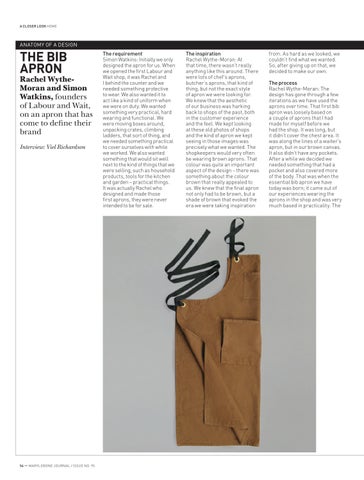A CLOSER LOOK HOME
ANATOMY OF A DESIGN
THE BIB APRON
Rachel WytheMoran and Simon Watkins, founders of Labour and Wait, on an apron that has come to define their brand Interview: Viel Richardson
54 — MARYLEBONE JOURNAL / ISSUE NO. 95
The requirement Simon Watkins: Initially we only designed the apron for us. When we opened the first Labour and Wait shop, it was Rachel and I behind the counter and we needed something protective to wear. We also wanted it to act like a kind of uniform when we were on duty. We wanted something very practical, hard wearing and functional. We were moving boxes around, unpacking crates, climbing ladders, that sort of thing, and we needed something practical to cover ourselves with while we worked. We also wanted something that would sit well next to the kind of things that we were selling, such as household products, tools for the kitchen and garden – practical things. It was actually Rachel who designed and made those first aprons, they were never intended to be for sale.
The inspiration Rachel Wythe-Moran: At that time, there wasn’t really anything like this around. There were lots of chef’s aprons, butcher’s aprons, that kind of thing, but not the exact style of apron we were looking for. We knew that the aesthetic of our business was harking back to shops of the past, both in the customer experience and the feel. We kept looking at these old photos of shops and the kind of apron we kept seeing in those images was precisely what we wanted. The shopkeepers would very often be wearing brown aprons. That colour was quite an important aspect of the design – there was something about the colour brown that really appealed to us. We knew that the final apron not only had to be brown, but a shade of brown that evoked the era we were taking inspiration
from. As hard as we looked, we couldn’t find what we wanted. So, after giving up on that, we decided to make our own. The process Rachel Wythe-Moran: The design has gone through a few iterations as we have used the aprons over time. That first bib apron was loosely based on a couple of aprons that I had made for myself before we had the shop. It was long, but it didn’t cover the chest area. It was along the lines of a waiter’s apron, but in our brown canvas. It also didn’t have any pockets. After a while we decided we needed something that had a pocket and also covered more of the body. That was when the essential bib apron we have today was born; it came out of our experiences wearing the aprons in the shop and was very much based in practicality. The




